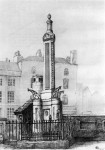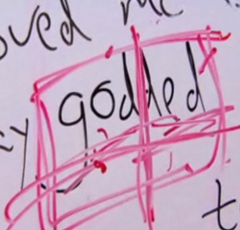 Sir Edward Simeon, who paid for the obelisk Sir John Soane designed for Reading's market place in 1804, doesn't get an entry in the Dictionary of National Biography. This seems a pity, since he was a director of the Bank of England and much given to local munificence – even if in the case of the obelsisk, it was partly intended to prop up his brother's campaign to get re-elected as local MP.
Sir Edward Simeon, who paid for the obelisk Sir John Soane designed for Reading's market place in 1804, doesn't get an entry in the Dictionary of National Biography. This seems a pity, since he was a director of the Bank of England and much given to local munificence – even if in the case of the obelsisk, it was partly intended to prop up his brother's campaign to get re-elected as local MP.
It has even been claimed that the monument's three lamps commemorated Simeon and his two brothers. Simeon also re-built the family home, Britwell Manor at Britwell Salome in Oxon – not Soane, although there is a monument to his parents there that makes me think of Soane's work. The house was later extensively restored by the designer David Hicks.
Soane, needless to say, is rather better represented in the DNB. As John Swan (1753-1837) he was born in Whitchurch in Oxfordshire. His father was a brick-layer, humble origins Soane may have been trying to hide when he first changed his name to Soan and then added the final 'e'.
His eccentricity and his highly original buildings, including his astonishing house in Lincoln's Inn (now a fascinating museum) mean he is well-cast for the role of romantic architect. He has been cited as an influence by many contemporary designers including Robert Venturi (Sainsbury wing of the National Gallery) and Philip Johnson (Chipendale-topped Sony building, New York).
 Soane built with clean lines, careful proportions and a skilled articulation of light that even inspired Sir Giles Gilbert Scott when he was asked to design the prototype British telephone box. Scott based the design on the mausoleum Soane built for his wife in old St Pancras churchyard.
Soane built with clean lines, careful proportions and a skilled articulation of light that even inspired Sir Giles Gilbert Scott when he was asked to design the prototype British telephone box. Scott based the design on the mausoleum Soane built for his wife in old St Pancras churchyard.
The Soane Museum holds drawings for both the obelisk and for Simmonds Brewery in Reading and they are now on show at a worthwile exhibition there. Pevsner attributed Seven Bridges House (now at the centre of the Oracle Shopping Centre in Bridge Street) to Soane, but this was a confusion with a house long since lost. Soane also designed a house for a Reading Mayor called Lancelot Austwick. It subsequently became Greyfrairs vicarage and was (some would say inevitably in Reading) demolished. Soane also designed alterations to South Hill Park in Bracknell (subsequently re-modelled) and to Wokefield Park near Mortimer.
A history of the Reading municipal charities (Blandy, 1960) describes how Simeon gave the Corporation of Reading £1,000 to pay for the gas to supply the lights on the obelisk ("erected and lighted forever at the expence of Edward Simeon, Esq" according to the inscription) and for the illumination of the clock over the nearby corn exchange. Surplus was to be used to maintain the obelisk, a responsibility that was not taken very seriously by the town. The gas lights (which in fact replaced earlier oil lamps) went out before the first world war, and as the obelisk decayed it sprouted a number of 'ornaments' including (for many years) a large road sign which obscured it, two subterranean lavatories, a little shed and a ventilation stack one writer described as 'sprouting up behind it like a goofy kid brother'. John Piper and John Betjeman both railed against the neglect of the monument – but to no result.
When it was built a contemporary letter writer to the Reading Mercury claimed the gift of the obelisk was "an attempt to bias the heads of the Borough in his favour by setting up in the market-place a paltry gewgaw thing without use or name". The lights did have the virtue of extending the working day at the very centre of the town, and no doubt deterred nefarious activities once the working day had ended. In the twentieth century other nefariousness – in the town that locked up Oscar Wilde – is assumed to have prompted the closure of the lavatories either side of the obelisk.
Only when a centenary loomed and they received some lottery money and a grant of £20,000 from the Soane Monument Trust was the Borough provoked into action. The obelisk is about to be restored by local stonemasons AF Jones and not before time, an exhibition currently at the town's museum commemorates local man Soane's importance.


 The county town of Berkshire a mecca for lovers of independently run coffee shops? Surely not. But a
The county town of Berkshire a mecca for lovers of independently run coffee shops? Surely not. But a 
